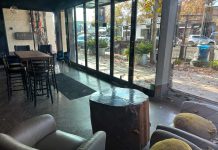GILROY
– Now the finger-crossing begins.
Despite several questions about the reasons for a nearly 25
percent jump in the cost estimates for the city’s new police
station
– to an overall total of nearly $25 million dollars – the City
Council informally authorized city staff to send the facility out
to bid Tuesday.
GILROY – Now the finger-crossing begins.
Despite several questions about the reasons for a nearly 25 percent jump in the cost estimates for the city’s new police station – to an overall total of nearly $25 million dollars – the City Council informally authorized city staff to send the facility out to bid Tuesday.
But that doesn’t necessarily mean that the station will continue as planned. The hope now is that contractors’ bids for the facility come in lower than the rising estimate – and don’t escalate even more.
And as the process moves along in coming months, other factors that could potentially cause the city to revisit the station could play out before Council reviews and makes decisions on those bids.
But officials also say that by waiting to put out the bids, costs could rise even higher. And because Council can reject them if they do, the city has nothing to lose in moving ahead, City Administrator Jay Baksa said Wednesday.
“We want to keep things going in motion,” Baksa said. “There’s that saying ‘one assumes for the best but plans for the worst’ – this is a classic example of that.”
Council reviewed the final station design and questioned several cost increases during Tuesday’s study session with police, city building officials and the station architect, which was designed to make them feel comfortable before the project enters the bid process. However, they did not do any retooling or request any changes or redesign work.
While the original cost estimate approved by Council for the state-of-the-art, 48,500-square-foot facility scheduled to open next year was roughly $19.5 million, officials now estimate those costs could rise as high as $25 million for the overall project.
Of the $18.97 million anticipated for the actual site and building work, $13.2 million goes toward the two-story building itself, officials said. Another $5.6 million is anticipated for a two-level underground parking garage with roughly 250 parking spaces, which is designed to serve several buildings in the city’s Civic Center as it grows and expands.
Another $4.5 million is estimated for “indirect” costs such as engineering and architectural services, inspections and project management. Demolition and utility infrastructure costs are expected to run roughly $1.6 million.
Tuesday, Baksa told Council that many things have been added to the project since it was originally conceived – especially as a result of feedback from the neighborhood surrounding the new facility site at 7301 Hanna St. And project costs aren’t really known until all of the elements are put together, he told Council.
“The cost is never really known until all the pieces of the product are put together … ” he said. “That’s the nature of projects.”
Project architect Larry Wolff of Rancho Cucamonga-based WLC architects elaborated on specifics during a brief presentation.
Increases in energy and fuel costs translated to higher costs for “core” materials such as concrete and structural steel, he said. An “enormous magnitude” of public works construction resulted in a tighter construction market and higher costs as well, he said.
Council had several questions after poring over a breakdown of the costs, estimated increases and cost-saving measures in greater detail.
Councilman Al Pinheiro singled out a jump in construction management costs, which rose from roughly $721,000 in the original estimate to roughly $1.7 million in the updated one. He singled out the proportion of those costs to the jump in the overall project cost.
“You’re talking about a $1 million increase to do $5 million worth of construction,” he said. “That’s an eye-catcher there.”
Baksa said the construction management would be subject to negotiation.
“This is not a fixed cost,” he said.
Pinheiro said he knows costs can change, but the new figures were a “big difference” he was not expecting. He inquired about taking up station construction issues in closed session over concern that public knowledge could work to bidders’ advantages.
“What happens when the actual bid is $8 to 9 million over?” he asked. “That’s the scary thing.”
Councilman Craig Gartman asked why the $1.6 million in demolition and utility costs weren’t included in original estimates, saying it was “utterly irresponsible” not to include them.
“To say we forgot to consider it, it just floored me,” he said.
Meanwhile, Mayor Tom Springer expressed surprise over a roughly $350,000 increase in paving and landscaping costs to $1.6 million and a nearly 50 percent jump in plan check, permit and fee costs.
“We should have a good handle on that,” he said. “We do that all the time.”
Springer pressed Wolff for assurances that the numbers would not go higher, noting that delays in-process could have major impacts on police operations.
“What I’m looking for is some reassurance we won’t see another change that looks to be of this magnitude,” Springer said.
Wolff said the project’s level of detail two years ago is much different than today’s, and stressed officials had done their best to review the project in greater detail and provide solid estimates. The firm uncovered “every little thing” to identify what it would cost, he said.
“I’m not saying it will be a $30 million project,” he said. “I’m not attempting to set the stage for other things to happen. … We’re not trying to maneuver. This is where we think it will come in.”
But there are no guarantees in construction bidding, he said.
“I’m 110 percent confident about the process,” he said. “I can’t give you 110 percent about the (bid) outcome because it’s speculation.”
Of the city’s last 10 bids, half came in above estimate and half below, Baksa added.
Wednesday, Baksa said that the process of putting the station out to bid could begin as early as next week. It will likely be a couple of months before Council sees the results, he said.
In the meanwhile, answers on other factors that could affect the station will also begin to roll in.
For instance, the status of the city’s operating budget could affect the timing of capital projects like the station. Officials have said volatile and slumping tax revenues and skyrocketing employee costs will already cause them to revisit their spending priorities – and that’s before they know what the impacts from the state’s shortfall will be.
While officials say the money to actually build the station is secure because it comes from a different source – impact fees levied on new development – they have raised the possibility of delays on construction projects if the revenues needed to operate the new facilities are reduced.
And the underlying assumptions by which the city collects those impact fees have also been questioned. The county’s Homebuilders Association has challenged several of the city’s impact fees, asserting they’re too high and not properly tied to growth levels.
The city has since commissioned a series of special studies to better demonstrate the relationship or so-called “nexus” between the fees and growth. Those studies may be complete next month, Baksa said.













